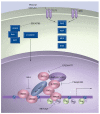Mechanisms of mixed-lineage leukemia
- PMID: 24563734
- PMCID: PMC3927937
- DOI: 10.2217/ijh.13.20
Mechanisms of mixed-lineage leukemia
Abstract
Advances in our understanding of the genetic determinants of leukemia have translated to better treatment options and improved survival of patients with acute myeloid and acute lymphoid leukemia. However, some leukemias, such as those bearing 11q23 (MLL) translocations, result in aggressive diseases with a relatively poor prognosis, despite improved treatments such as allogeneic hematopoietic stem cell transplantation. This article will briefly review the functions and regulation of wild-type MLL during normal hematopoiesis, while focusing on recent advances in our understanding of the molecular mechanisms governing MLL leukemias. The transcriptional targets, cooperating signaling pathways and molecular machinery involved in MLL-associated leukemias will be discussed, as well as how these may be harnessed for more personalized treatment of this disease.
Figures


Similar articles
-
The pathogenesis of mixed-lineage leukemia.Annu Rev Pathol. 2012;7:283-301. doi: 10.1146/annurev-pathol-011811-132434. Epub 2011 Oct 17. Annu Rev Pathol. 2012. PMID: 22017583 Free PMC article. Review.
-
Rearrangement of the MLL gene in acute lymphoblastic and acute myeloid leukemias with 11q23 chromosomal translocations.N Engl J Med. 1993 Sep 23;329(13):909-14. doi: 10.1056/NEJM199309233291302. N Engl J Med. 1993. PMID: 8361504
-
MLL-Rearranged Acute Leukemia with t(4;11)(q21;q23)-Current Treatment Options. Is There a Role for CAR-T Cell Therapy?Cells. 2019 Oct 29;8(11):1341. doi: 10.3390/cells8111341. Cells. 2019. PMID: 31671855 Free PMC article. Review.
-
The molecular biology of mixed lineage leukemia.Haematologica. 2009 Jul;94(7):984-93. doi: 10.3324/haematol.2008.002436. Epub 2009 Jun 16. Haematologica. 2009. PMID: 19535349 Free PMC article. Review.
-
New insights into MLL gene rearranged acute leukemias using gene expression profiling: shared pathways, lineage commitment, and partner genes.Leukemia. 2005 Jun;19(6):953-64. doi: 10.1038/sj.leu.2403746. Leukemia. 2005. PMID: 15815718
Cited by
-
Acute myeloid leukemia with t(10;11): a pathological entity with distinct clinical presentation.Clin Lymphoma Myeloma Leuk. 2015 Jan;15(1):47-51. doi: 10.1016/j.clml.2014.06.022. Epub 2014 Jun 21. Clin Lymphoma Myeloma Leuk. 2015. PMID: 25081372 Free PMC article.
-
[Clinical efficacy observation of allogeneic hematopoietic stem cell transplantation in 16 patients with mixed phenotype acute leukemia].Zhonghua Xue Ye Xue Za Zhi. 2015 Nov;36(11):963-5. doi: 10.3760/cma.j.issn.0253-2727.2015.11.017. Zhonghua Xue Ye Xue Za Zhi. 2015. PMID: 26632474 Free PMC article. Chinese. No abstract available.
-
Rare KMT2A-ELL and Novel ZNF56-KMT2A Fusion Genes in Pediatric T-cell Acute Lymphoblastic Leukemia.Cancer Genomics Proteomics. 2021 Mar-Apr;18(2):121-131. doi: 10.21873/cgp.20247. Cancer Genomics Proteomics. 2021. PMID: 33608309 Free PMC article. Review.
-
Rare MLL-ELL fusion transcripts in childhood acute myeloid leukemia-association with young age and myeloid sarcomas?Exp Hematol Oncol. 2016 Mar 5;5:8. doi: 10.1186/s40164-016-0037-2. eCollection 2015. Exp Hematol Oncol. 2016. PMID: 26949571 Free PMC article.
-
Epigenetic roots of immunologic disease and new methods for examining chromatin regulatory pathways.Immunol Cell Biol. 2015 Mar;93(3):261-70. doi: 10.1038/icb.2014.105. Epub 2014 Dec 23. Immunol Cell Biol. 2015. PMID: 25533290 Review.
References
-
- Cimino G, Moir DT, Canaani O, et al. Cloning of ALL-1, the locus involved in leukemias with the t(4;11)(q21;q23), t(9;11) (p22;q23), and t(11;19)(q23;p13) chromosome translocations. Cancer Res. 1991;51(24):6712–6714. - PubMed
-
- Tkachuk DC, Kohler S, Cleary ML. Involvement of a homolog of Drosophila trithorax by 11q23 chromosomal translocations in acute leukemias. Cell. 1992;71(4):691–700. - PubMed
-
- Streubel B, Valent P, Jager U, et al. Amplification of the MLL gene on double minutes, a homogeneously staining region, and ring chromosomes in five patients with acute myeloid leukemia or myelodysplastic syndrome. Genes Chromosomes Cancer. 2000;27(4):380–386. - PubMed
-
- Caligiuri MA, Schichman SA, Strout MP, et al. Molecular rearrangement of the ALL-1 gene in acute myeloid leukemia without cytogenetic evidence of 11q23 chromosomal translocations. Cancer Res. 1994;54(2):370–373. - PubMed
Grants and funding
LinkOut - more resources
Full Text Sources
Other Literature Sources
